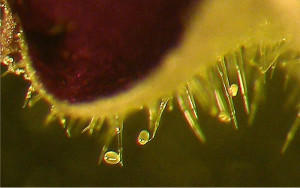Acarianul Parasitiformes
 It is a new mite about which not much information is known.
It is a new mite about which not much information is known.
The behavior of this mite, the shape of the eggs, the way and where they are deposited suggests that we are dealing with a partially herbivorous parasitic mite. It is most likely a representative of the Ascoidea mite family.
Where should you look??
Their presence is usually signaled by the small white spots on the flower petals, of the empty and dry crusts of the mites that have molted, easily found in the recesses on the wavy edge of flowers.
The Parasitiformes mite lays eggs in the ajar buttons of flowers on top of villi at the base of the pestle. Actually, This is also the favorite place where it parasitizes.
In a contaminated bud usually live 5-7 mites together with the eggs laid by them, which can reach the order of tens.

Parasitiformes mite also parasitizes at the growth point of flower chicks, formed between the base leaves and the stem. They don't stay here long and they don't do much damage to the plant, probably due to air humidity. Like other mites, It does not support dry air.
Although they are small, with a length of 0.2 mm it moves quite fast. The first pair of front feet is not involved in everyday walking. The mite flutters it through the air, combing the surface of the plant.
The coloring and shape of the body are similar to those of the transparent greenhouse mite, Parasitiformes mite being a bit darker in color. From the tip of the abdomen on top there is a glossy stripe that reaches to the middle of the abdomen. The surface of the abdomen is smooth and glossy.
Unlike other mites, The locomotor limbs are well developed and proportional (compared to those of the transparent mite). Eggs are glossy, transparent and stored exclusively on top of villi.
Parasitiformes mite in action
If we have found a contaminated flower, It is desirable to investigate and the ajar buds in the vicinity.
The methods of combating this mite are similar to those used in other mites. It is recommended that buds be removed from the contaminated plant. After the plant has been treated, On the surface of the leaves and on the growth points of the plant, a solution of water and zoo shampoo will be sprayed to preserve longer the acaricide solution with which the plant was treated. In greenhouse conditions, Actelic will be used.

